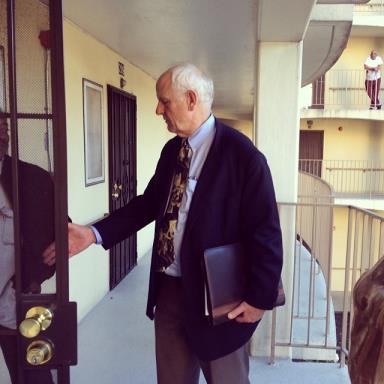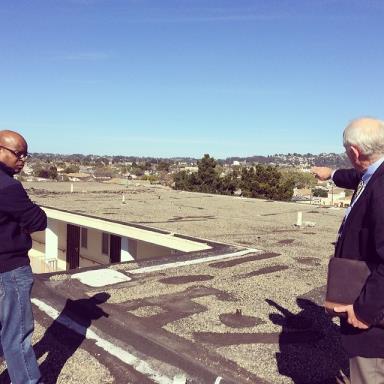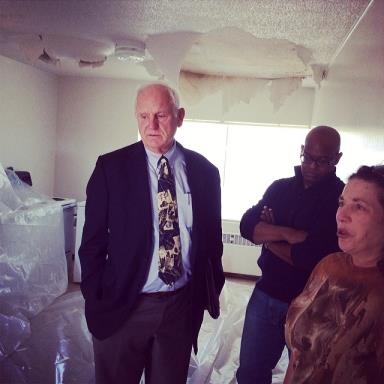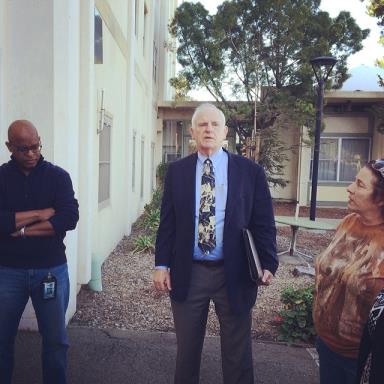The reality of Richmond’s public housing is a lot like the parable of “feeling the elephant,” an ancient tale wherein a group of blind men (or men in the dark) touch an elephant to learn what it is like. Each one feels a different part, but only one part, such as the side or the tusk. They then compare notes and learn that they are in complete disagreement.
The stories differ primarily in how the elephant's body parts are described, how violent the conflict becomes and how (or if) the conflict among the men and their perspectives is resolved.
In some versions, they stop talking, start listening and collaborate to "see" the full elephant. When a sighted man walks by and sees the entire elephant all at once, they also learn they are blind. While one's subjective experience is true, it may not be the totality of truth. If the sighted man was deaf, he would not hear the elephant bellow.
Tom Butt Description
I went back to Hacienda yesterday, March 7, for another tour. I asked Robert Rogers and Ellen Seskin to accompany me, mainly for a reality check to see if others shared my impressions, or if we all were feeling different parts of the same elephant.
Except when we were talking with some residents, we were also accompanied by Tim Jones and Debra Holter of the Housing Authority.
We first looked at the expansion joint that a HUD inspector had erroneously written up as a serious structural problem. I explained that it was a part of the building’s engineering design, but that it had simply lost its waterproofing seal and looked bad. I also noted that the building needed painting badly to seal up some non-structural hairline cracks in the concrete that could be leak sources.
We then went up to the nearly 50-year-old roof that is the source of numerous leaks into the mostly vacated 6th floor. Bid documents are being prepared for a new roof, but Tim Jones said he would hold off on spending the nearly $500,000 needed to replace it if HUD agreed to pay for the disposition of the building.
The elevators were working, although Tim said the maintenance company had been called to work on the eastern one again because the doors were acting up. He confirmed what he had told me previously that the elevators had been damaged by vandalism. Some critical operational components of the doors had been removed, one of the mysterious things that makes public housing maintenance challenging.
I also asked Tim about security, and he said the security company had shown more motivation recently and were doing a better job. Since security is there only at night, there was none present during our visit.
We looked at a typical vacant apartment that had been prepared for a new tenant. It was clean and functional. The original aluminum window was operable but did not slide easily, a potential problem for people with physical disabilities, probably typical throughout the building. There were no bugs, no mold and no mice. There is nothing to attract or support vermin in an empty apartment. These things typically move in after people move in.
We also looked at a vacant apartment on the 6th floor that had been taken off-line due to chronic roof leaks. I think Ellen and Robert were impressed, if not shocked, by the sagging and almost grotesque water damaged ceiling finish. As a forensic architect used to seeing these things, I noted that there was no evidence of structural damage or mold. It was ugly but only skin deep.
After that, we talked to five residents that we ran into at random. I introduced myself to each one, and Robert and Ellen introduced themselves. I asked each of them how they liked living at the Hacienda and if they had any problems or complaints.
I don’t want to use their names without their permission, so I’ll just refer to them as residents.
- Resident No. 1 we met in the elevator. He said he had no complaints. He said he had some mildew in his unit but had not complained about it to the RHA. We asked to see his unit, but he was headed somewhere else and did not have time.
- Resident No. 2 said he had no complaints.
- Resident No. 3 said she had lived there for 14 years and was very happy living there. She particularly liked that fact that Hacienda is within easy walking distance to services, such as stores and the post office. Without is even asking, she invited us to explore her apartment, which was clean and well-kept. She said that the Hacienda should not be torn down.
- Resident No. 4 had been there less than a year. He had no complaints but noted that he had been dealing with roaches. He also invited us into his apartment to look around. The RHA had sent an exterminator, but he also hired his own. He was using some kind of roach powder to keep them away, maybe borax or boric acid. He acknowledged that part of the problem was due to other residents leaving garbage around. I asked him if he was peeved at the RHA about the roaches, and he said no. The only complaint he has was that there were too many cars in the parking lot, some of which may not belong to residents.
- Resident No. 5 said living there was generally satisfactory. He showed us some deteriorated weather stripping on his front door and told us he had to use some WD-40 on his windows, but they were okay now. He said he had some problems with roaches in the past but not now. He also noted its convenient location.
I believe we all agreed that the stairways and entrance balconies were clean. The courtyard was green and well-kept. The views were great. No one we met complained about bedbugs.
As we exited the elevator on the first floor, Dolores Johnson, a former president of the resident council, upbraided me about my remark regarding hotel rooms and maid service. More on that later.
In a Contra Costa Times article, Ms. Johnson was quoted as follows from the meeting earlier in the week:
"There are no happy tenants here," said Dolores Johnson, a 69-year-old resident of the aging, concrete building. City officials vowed immediate action, saying residents needed to be moved out of the building.
My impression is that what we saw did not comport with the descriptions in the media, including, “substandard conditions,” “squalid conditions,” and “uninhabitable building.” Clearly, Hacienda needs a capital infusion for major rehabilitation and maintenance, but it is far from the disaster described in the media.

Talking to a resident, photo by Robert Rogers

Up on the roof, photo by Robert Rogers

Inside a fifth floor apartment with leaks for the roof, photo by Robert Rogers

Out in front, photo by Robert Rogers
Ellen Seskin Description
I was out there with Tom and Robert today. My impression was that, aside from the roof and the CONSIDERABLE damage that resulted, it is in amazingly good shape. The ceiling of the entire top floor, from what we saw, will probably need to be torn out completely and be redone, and the very least. There is probably water damage in the walls, as well. I was amazed that I didn't smell any mold or mildew. I'm sure there is some, but probably much less than I would have expected. I was shocked at how clean the apartments we saw were - the stereotype that people in public housing don't care about things like that is NOT TRUE.
I asked Ellen to review my draft account, and she responded: “Based on what I saw, other than adding how bad the ceiling looked in the second unit we saw on the top floor, I agree with everything you've said. P.S. I'm assuming you've seen some of the discussion on Facebook regarding our visit. It amazes me how some people want to believe what they believe, even if evidence doesn't confirm it.”
Robert Rogers Description
I took a tour of the Hacienda housing project today with Tom Butt, Director Tim Jones and Ellen Seskin. We went to the roof first. 40-year old roof was in poor condition and pocked with patches.
Went to top floor next. 24 of 26 units vacant. Entered a pristine vacant room ready for rental. Tom remarked on the nice views.
I then suggested that we see a room unfit for rental. We walked into a room with extensive water damage, the ceilings cracked, splayed and sagging. It was clear that significant volumes of water from the bad roof caused the damage, and had entered through the ceiling. Where water went after entering room was unclear. A staff member said that one of the two units currently occupied on the top floor would have to soon be vacated due to water leaks.
From there we went to a lower floor, in one of the two elevators that staff said we should use. En route, we encountered a man who said his lower floor apartment was beset by "mildew." Tom asked to see, but the man said he had to go.
We then encountered another woman, Dolores Johnson. She told Tom that she and her fellow residents "weren't asking for any maid service," a clear rebuke of Tom's recent comments in the CCTimes about public housing tenants expecting maid services.
On lower floors, Tom knocked on doors and chatted up at least four residents. We entered their units. Looked generally clean and well kept. The tenants were generally positive about their experience living at Hacienda. Tom remarked that the staircases and walkways looked relatively clean. They did.
In one unit, we spotted roach motels. The resident said they were given to her by staff to combat roach infestation.
In another unit, a man had white powder lining his kitchen floor and cabinets. Tom asked if it was "Borax," the man replied that it was "acid," presumably boric acid, and assured us that he didn't have any children so it was no threat to them. The man said he needed to use it to keep roaches away, and added that in December he had paid $77 to an exterminator out of his own pocket. The exterminator applied poisons behind the walls, the man said.
We soon departed, after a little more than one hour on site. Tom indicated that he felt his previous assessments of the building being in relatively good condition were vindicated by the visit.
Hotel Rooms and Maid Service
Following a recent drumbeat of media articles and videos featuring Hacienda residents demonstrating the failure of management to address complaints ranging from vermin to vice, and calls from some of my fellow City Council members to bulldoze Hacienda, I was both appalled and frustrated with the complete lack of circumspection. From my own inspections and those of others, as well as statements from tenants, I knew that some of the problems, particularly those related to mice and roaches were at least partly a result of some tenants leaving out food and garbage. This is as much a tenant problem as it is a management problem. In a Facebook post responding to even more accusations of management failures, I wrote, “There are hundreds of people on the waiting list for these public housing units that provide clean, safe and affordable housing at far below market rates. It seems that once people get into public housing, they think they are in a hotel with maid service."
I concede that generalization was both inaccurate and insensitive. Most of the residents at Hacienda follow the rules and keep their apartments clean and neat, and for any of them who were offended, I apologize.
However, successful operation of public housing is a two-way street. The Housing Authority is required by HUD and state law to maintain the units in a habitable condition, which includes an absence of mold, mice and roaches. They can’t do this alone. Residents are also required to follow rules. See Your Friendly Guide to Public Housing. In an apartment building, roaches don’t have boundaries. When one tenant leaves a mess, roaches can spread throughout the building.
My observations were verified by Felix Hunziker, a Police Commission member, who wrote in the same Facebook string:
I think Tom has a valid point - it is a two way street. My one and only visit to the Hacienda was on an RPD ride-along where we visited the apartment of an elderly disabled gentleman whose mentally ill son was causing problems.
That apartment was filthy. There were old, open food containers everywhere, tins of spoiled cat food on the counter, piles of unwashed laundry strewn about, unwashed sticky floor, and several cockroaches checking us out. The smell was so bad I had to breathe through my shirt.
I'm not suggesting that what I observed is the norm, nor am I suggesting that the RHA hasn't failed to perform their duties adequately. But if a tenant isn't capable of caring for him/herself, since when is it the Richmond Housing Authority's job to do so? Can you blame the RHA if there are repeated problems in such a unit?
Back to feeling the elephant, I think that the perception of Robert Rogers, Ellen Seskin and me were marginally different, but we agreed on more than we differed on. We were essentially seeing the same elephant, although others weren’t. Remarkably absent in our visit were any cries of filth, fear and squalor, which had recently echoed through the media.
|

